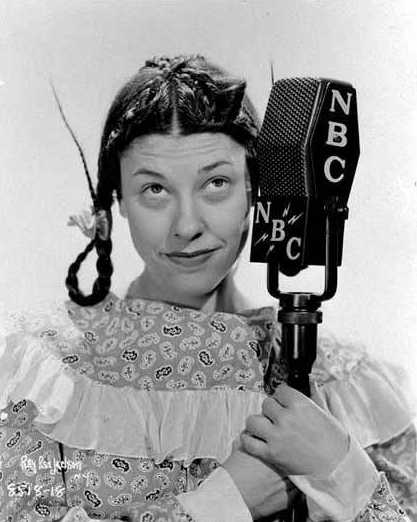Judy Canova: The Queen of Hillbilly Hokum

When she was a kid, Judy Canova once wrote that she wasn't a happy child. The only thing that could take her mind off herself and her personal unhappiness was music. Born Julietta, she started singing popular songs on a Jacksonville, Florida, radio station together with her brother Zeke and her sister Anne when she was just 12. When she sang she would forget her troubles.
Although her mother took her three children to the Carolina hills for the summer, Canova stayed inside her cabin unhappy and sober-faced. She used to listen to the mournfully amusing sound of the native hill people. She had forgotten how to laugh, but found herself chuckling at the nasal twang of the voices, the funny words, the odd pronunciations -- the song lore of the hillbilly! In the weeks there in those Carolina hills, she committed to memory every song she heard, every nasal twang, every oddity of pronunciation. It became her idea to do a routine with this hillbilly music in it.
In 1933 the three singing Canovas headed for the bright lights of New York. The Village Barn advertised for a hillbilly act, and the Canovas dragged out Judy's mountain soungs, bought some calico and got the job. The honest laughter of those nightly packed houses paid off. After the Barn, a 70-week RKO vaudeville tour, an audition and contract for the Rudy Vallee program in 1933, a chance at an important stage show, Calling All Stars, in 1934 with Gertrude Niesen, more radio, her first Broadway review The Ziegfield Follies of 1936, and then Hollywood.
Her big break in Hollywood was a bit part without billing in In Caliente. Wini Shaw, a popular singer of the day, was to sing "The Lady in Red" in a nightclub scene, and one of the most beautiful and extravagant production numbers had been created by producer Busby Berkeley. Just as it ended, from behind a pillar Canova appeared in a costume resembling Wini Shaw's. The moment she opened her mouth to sing all the effect created by the original performance was destroyed. The audience howled. Canova immediately got other parts suited to her hillbilly hokum. Few knew that the absurd voice she used to butcher songs with had been trained for classical singing.
In the summer of 1943 she landed her own radio show for the Colgate-Palmolive-Peet Company. She surrounded herself with a complement of comedians in a program which depicted a socially aspiring "unacceptable" and her snooty neighbors. Ruby Dandridge was boisterously blithe and giggly Geranium, Canova's maid and cook; Hans Conreid was Canova's house guest Mr. Hemingway, a rather grouchy character; Verna Felton was her friend Miz Pierce; Sheldon Leonard played Joe Crunchmiller, Judy's Brooklynese boyfriend; while the Sportmen Quartet, Gale Gordon, Elvia Allman, Mel Blanc, and others completed the cast. Blanc was the character Pedro. His expression, "Pardon me for talking in your face, seniorita," became a household remark during the '40s. Another character introduced on the Judy Canova Show was her Cousin Ureenus who used to eat chopped liver ice cream. On signing off, Canova would sing the popular song, "Goodnight Sweetheart."
It was noted that few Americans had much contact with real hillbilly humor, but through radio's facsimile, millions of them giggled at the leading lady of pseudohillbilly comedians as she delivered ripe corn in a deep southern drawl. Her flair for reading corn in a raucous drawling voice made her one of radio's favorite personalities. Canova appeared in a number of films and was a recording artist for RCA -- and originated the pigtail fad which swept the country's campuses.
Variety credits Canova's appearance in 1939 as the first hillbilly act ever to appear on television. She formed her own TV production company in 1957 but was rarely seen on that medium, with the exception of some guest appearances on the Huckleberry Finn Show in the late '50s. She also made an occasional rodeo appearance after retiring from radio.
Reid G. Hansen in Return With Us Now, September 1983
Add a Comment
All comments are moderated before publication. These HTML tags are permitted: <p>, <b>, <i>, <a>, and <blockquote>.
Top 10 Articles
- The Marriage of Don Ameche and Honore Prendergast
- The Night Arthur Godfrey Fired a Singer On Live Radio
- Early Radio Announcers Invented Their Profession in the 1920s
- The Mythical Town of East Tincup, Colorado
- The Earliest Radio Shows of the 1920s
- The Great Radio Detectives of the 1950s
- The Home Life of Jack Benny
- Why Vladimir Horowitz Stopped Performing in the 1930s
- Judy Canova: The Queen of Hillbilly Hokum
- Some of the Unsung Heroes of Radio

